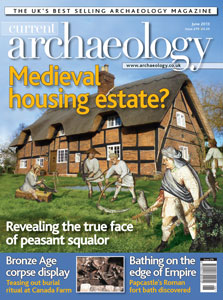What was life really like for Medieval peasants? Renowned as the epitome of poverty, they appear as stock images performing hard manual labour in the margins of illustrated manuscripts. With the squalor they faced memorably lampooned by Monty Python, among others, it has always been assumed that the ramshackle hovels they called home have long since decayed. Not so. A recent programme of radiocarbon dating has revealed that thousands of their homes still stand in the Midlands and Wales. They are shedding new light on a peasant’s lot.
When ploughing revealed traces of a ring ditch near the Great Dorset Cursus, it appeared to be just another satellite structure speckling the environs of this monumental earthwork. Excavation revealed a fascinating set of burials and tantalising traces of a macabre Bronze Age tradition of displaying the deceased. Are drill holes in the bones traces of an attempt to peg decaying corpses together?
Regeneration of Southampton’s former French Quarter provided the opportunity for the largest ever examination of the city’s historic core. The results tell a story of boom and bust in a vibrant port town, as armies, merchants and artisans came and went.
Finally, excavations in Cumbria have unearthed Papcastle Roman fort’s bathhouse. Intended to allow Rome’s soldiers to enjoy the trappings of Classical civilisation in the frontier zone, by the early 3rd century AD the heating system was choked with dead goats. What does this mean for military hygiene, and why did a body suffering multiple pathologies end up in the ruins?
FEATURES/n
/n
PEASANT HOUSES IN MIDLAND ENGLAND/n
How the Black Death prompted a building boom
While high-status Medieval houses are a celebrated part of the historic environment, new evidence suggests that many more humble dwellings also survive in English villages.
KEEPING THE FAMILY TOGETHER/n
Canada Farm’s Bronze Age burials
What do enigmatic signs of defleshing and drilling on seven ancient skeletons add to our understanding of whether the prehistoric dead were left to rest in peace?
SOUTHAMPTON’S FRENCH QUARTER/n
Trade, Prosperity, War and Poverty at a Channel port
The largest excavation to take place in Southampton’s historic centre has shed new light on the city’s French connections, before and after the Norman Conquest.
RETURN TO DERVENTIO/n
The body in the bath house
Investigations on the other side of the river to Papcastle’s extensive Roman remains have revealed traces of more substantial buildings, and an unexpected burial.
NEWS/n
Bedale’s hoarded secrets; Roman track and ore; Walbrook channel: mystery panel; Ringing the changes?; Flodden field day; Edinburgh: a knight’s tale?; Unpicking hidden Holcombe; Fermanagh crannog’s remains
REGULARS/n
Context
Rediscovering Worsley New Hall, Salford
Reviews
Iron Age Hillforts in Britain and Beyond; Viking identities; Handbook to Roman Legionary Fortresses; Worlds of Arthur
Sherds
Chris Catling’s irreverent take on heritage issues.
Last Word
CA’s Editor in Chief Andrew Selkirk examines the balance between authenticity and cost when restoring historic buildings.
Odd Socs
The Traditional Paint Forum

